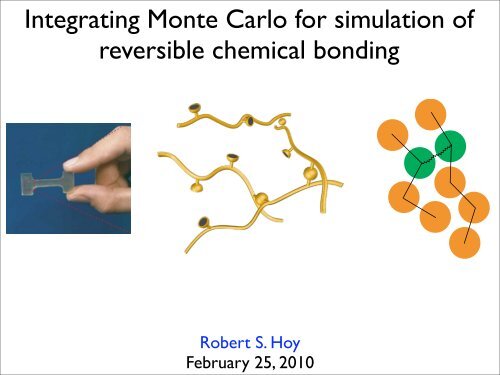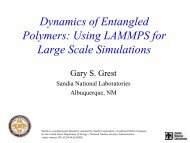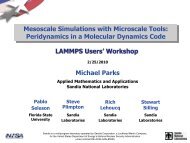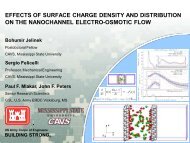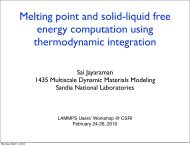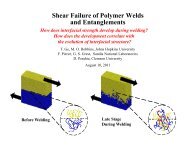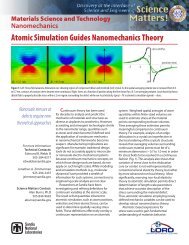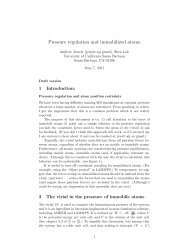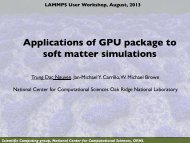Integrating Monte Carlo for simulation of reversible ... - Lammps
Integrating Monte Carlo for simulation of reversible ... - Lammps
Integrating Monte Carlo for simulation of reversible ... - Lammps
You also want an ePaper? Increase the reach of your titles
YUMPU automatically turns print PDFs into web optimized ePapers that Google loves.
<strong>Integrating</strong> <strong>Monte</strong> <strong>Carlo</strong> <strong>for</strong> <strong>simulation</strong> <strong>of</strong><br />
<strong>reversible</strong> chemical bonding<br />
Robert S. Hoy<br />
February 25, 2010
Computing Challenges<br />
• realistic dynamics<br />
•<br />
•<br />
•<br />
variable “chemical’’ kinetics<br />
Need model with<br />
controllable bonding topology (~ typical real systems)<br />
ability to treat inhomogeneous systems<br />
Must be coarse-grained to access relevant length, time scales<br />
Limitations <strong>of</strong> Previous Work<br />
• early attempts used lattice MC; can’t apply stress, strain<br />
•<br />
standard “pure” MD sims use deterministic bond breaking/<strong>for</strong>mation;<br />
traditionally no control <strong>of</strong> kinetics/binding topology<br />
• MC sims difficult to capture realistic dynamics, esp. correlated relaxations
Bead-Spring Polymer Model<br />
Kremer & Grest, 1980s-present<br />
U LJ (r) = 4u 0<br />
(( (a<br />
r<br />
) 12<br />
−<br />
( a<br />
r c<br />
) 12<br />
)<br />
JobTalk Equatio<br />
(( (a ) 12 ( ) ) (<br />
a<br />
12 (a ) 6 ( ) ))<br />
a<br />
6<br />
U LJ (r) = 4u 0 − − −<br />
r r c r r c<br />
−<br />
(1)<br />
( (a<br />
r<br />
) 6<br />
−<br />
captures RW structure, chain stiffness<br />
and uncrossability, excluded volume<br />
& adhesion, but no “chemistry’’<br />
N spherical monomers per chain, all<br />
interact via LJ, covalently bonded also<br />
have FENE<br />
U<br />
U F ENE − 1 2 kR2 0 log(1 − (r/R 0) 2 ) (2)<br />
F ENE (r) = − 1 2 kR2 0 log(1 − (r/R 0) 2 )<br />
Y (λ) = Laffine pp<br />
(λ)<br />
L 0 pp<br />
Y (λ) = Laffine pp<br />
(λ)<br />
U bend = k bend (1 − cos(θ)) (3)<br />
LJ<br />
U bend = k bend (1 − cos(θ))<br />
L 0 pp<br />
= 1 2<br />
(<br />
= 1 2<br />
λ + sin−1 ( √ 1 − λ 3 )<br />
√ λ − λ<br />
4<br />
(<br />
)<br />
(4)<br />
λ + sin−1 ( √ 1 − λ 3 )<br />
√ λ − λ<br />
4<br />
FENE<br />
strength, range <strong>of</strong> adhesive interactions<br />
varied by changing rc<br />
Simulate with MD: integrate Newton’s<br />
eqns <strong>for</strong> all monomers
Hybrid MD/MC Model <strong>for</strong> Associating Polymers 1<br />
Fraction cst <strong>of</strong> monomers are “sticky” (green)<br />
G R = C 0 + C 1 × σ flow (1)<br />
Use Metropolis <strong>Monte</strong> <strong>Carlo</strong> to <strong>for</strong>m/break<br />
<strong>reversible</strong> bonds between SMs with potential<br />
U F ENE−SB (h, r) =−h + U F ENE (r) − U F ENE (r min ) (2)<br />
Sticky bonds intended to be “<strong>reversible</strong> equivalent <strong>of</strong><br />
the covalent bond” (Sijbesma et al, Science 1997)<br />
<strong>Monte</strong> <strong>Carlo</strong> attempt frequency 1/τMC<br />
LJ<br />
FENE-SB<br />
Restrict SMs to binary, “one at a time” bonding:<br />
reflect SMs used in many recent experiments<br />
Vary two parameters:<br />
h = binding energy ~ thermodynamics<br />
τMC ~ kinetics<br />
Model thoroughly<br />
validated, has 2nd-order<br />
kinetics with Arrhenius<br />
activation<br />
Similar method applied to linear equilbrium polymers by Ryckaert et al, 2006-2009
Serial/Parallel Hybrid Method<br />
Serial Parallel<br />
Be<strong>for</strong>e After<br />
Be<strong>for</strong>e After<br />
A<br />
A<br />
A<br />
A<br />
i<br />
i<br />
i<br />
i<br />
j<br />
j<br />
j<br />
j<br />
B<br />
B<br />
Parallel MC very difficult!<br />
(changes have to be communicated<br />
instantaneously and not interfere)<br />
Added serial MC capability to<br />
LAMMPS<br />
Pause (parallel) MD, gather info on<br />
sticky monomers, use Metropolis MC<br />
to update sticky bonds, redistribute SB<br />
topology to all procs, restart MD<br />
parallel-efficiency decrease ~<br />
SM concentration x fMC<br />
fMC = MC steps/ MD steps ~ .01-.1
Differences from Fix Bond Create/Break<br />
(the standard LAMMPS package)<br />
Good:<br />
Uses Metropolis <strong>Monte</strong> <strong>Carlo</strong> (bond-potential based ΔE, Boltzmann<br />
weighting), satisfies “balance” (Manousiouthakis & Deem 99),<br />
modifiable to satisfy detailed balance<br />
Doesn’t require special_bonds 011<br />
Bad:<br />
MC part not clearly parallelizable! Had to modify many .cpp files,<br />
uses and classes: - is currently in Steve’s “high<br />
energy barrier mode” <strong>for</strong> integration<br />
Question:<br />
Worth integrating into standard LAMMPS dist?
Details, Details<br />
• code implemented by modifying bond_fene.cpp<br />
• Sticky atoms and sticky bonds both different type than<br />
nonsticky -- bond and neighbor lists easily accessible<br />
• select sticky neighbors (within distance R0), gather lists<br />
<strong>of</strong> positions to processor 0<br />
• use dynamical allocation <strong>of</strong> sticky neighbor list depth to<br />
minimize interproc communication<br />
• use std-lib random_shuffle, various flags to impose<br />
binary-bonding, improve efficiency
Outlook<br />
• implement as LAMMPS fix so can be used with variety<br />
<strong>of</strong> bonding potentials?<br />
• possible to implement “proper’’ parallel MC? (big<br />
problem: communication); “checkerboard” possible?<br />
• or keep serial but improve efficiency?<br />
Ref: R. S. Hoy and G. H. Fredrickson, J. Chem. Phys. 131, 224902 (2009)<br />
Thanks: Glenn Fredrickson, Steve Plimpton, NSF MRSEC funding


